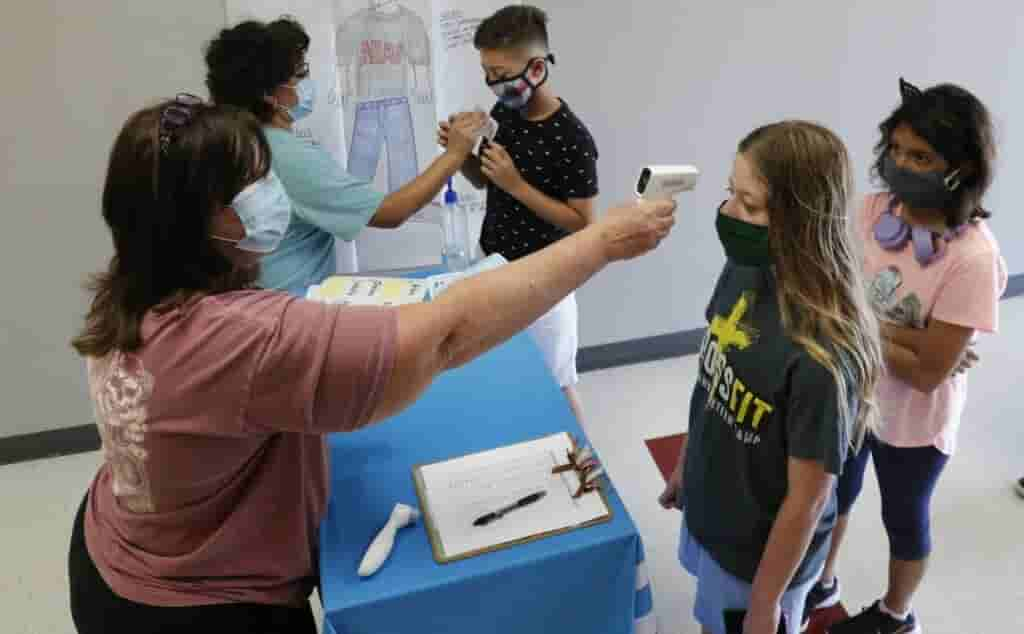As the Delta variant of the COVID19 virus continues to bring a surge of deaths and cases, more children are getting infected by the virus, just as doctors have feared. And the school year has just started.
According to Dr. Edith Bracho- Sanchez, associate professor of pediatrics at Columbia University Irving Medical Center, what they are seeing right now is extremely concerning, CNN reported.
“This virus is really going for the people who are not vaccinated. And among those people are children who don’t qualify for the vaccine and children and teens who qualify but are choosing not to get it.”
In the latest statistics, as of Tuesday, according to data from the US Department of Health and Human Services, a record-high 2, 396 children were hospitalized due to COVID19.
At least 369 pediatric COVID19 patients were admitted to hospitals daily during the week ending September 6, data from the U.S. Centers for Disease Control and Prevention.
According to CDC data, since August 2020, more than 55, 000 children have been hospitalized due to COVID19 and most of these children had no pre-existing conditions.

As cases of children contracting COVID-19 increase, deaths are also increasing. According to CDC data, as of Wednesday, there are already 520 pediatric deaths.
According to doctors, it is essential to protect children against the Delta variant not only for their health but to also push in-person learning and help prevent other variants from developing and setting the entire country back.
RISING PEDIATRIC CASES IN A WEEK
The American Academy of Pediatrics said, at present, “child cases have increased exponentially, with over 750,000 cases added between August 5 and September 2.”
“About 252,000 cases were added the past week, the largest number of child cases in a week since the pandemic began.”
Children now make up more than 26% of new COVID19 cases, AAP confirmed.
According to Dr. Jon McCullers, pediatrician-in-chief at Le Bonheur Children’s Hospital in Memphis, “We have seen a significant surge in cases roughly for the last four weeks, roughly corresponding to the time when school got in.”
“Interestingly, we’re seeing about three times the number of hospitalizations that we saw during our during our peak during the winter,” he added.
KDS WITHOUT PRE-EXISTING CONDITIONS ARE ALSO GETTING HOSPITALIZED
At 46.4%, almost half of children being hospitalized with COVID-19 that were recorded between March 2020 and June 2021 had no known underlying condition, according to CDC data from almost 100 U.S. counties.
The Delta variant is proving that healthy kids can get hit hard with the virus.
According to Dr. Susannah Hills, a pediatric airway surgeon at Columbia University Medical Center, “the majority of kids that I’ve seen get really sick (with Covid-19) have been kids with other illnesses or comorbid conditions.”
“But now, the difference with this Delta variant is that we’re seeing kids who may not necessarily have comorbid conditions also end up in the hospital.”
COVID-19 AND MISC-C
In some cases, doctors observed that children who start with mild or no symptoms at all from COIVD-19 end up hospitalized after weeks or months with a condition called MIS-C or multisystem inflammatory syndrome in children.
MIS-C is “a rare but serious condition associated with COVID-19 in which different body parts become inflamed, including the heart, lungs, kidneys, brain, skin, eyes, or gastrointestinal organs,” the CDC says.
It happens when “the virus induces your body to make an immune response against your own blood vessels” — which can cause inflammation of the blood vessels, said pediatrician Dr. Paul Offit, director of the Vaccine Education Center at the Children’s Hospital in Philadelphia.
There are at least, 4, 661 cases of MISC-C, with 41 deaths, the CDC confirmed.
“Usually children are picked up incidentally as having (coronavirus). Someone in the family was infected, a friend was infected, so they got a PCR test. And they’re found to be positive. … Then they’re fine,” Offit said.
“Then a month goes by, and they develop a high fever. And evidence of lung, liver, kidney or heart damage. That’s when they come to our hospital.”
About 99% of MIS-C patients were positive for the virus while the other 1% had contact with someone who had COVID19, the CDC said.
The agency said it is “working to learn more about why some children and adolescents develop MIS-C after having COVID-19 or contact with someone with COVID-19, while others do not.”
“Based on what we know now about MIS-C, the best way you can protect your child is by taking everyday actions to prevent your child and the entire household from getting the virus that causes COVID-19.”
According to CDC Director, Dr. Rochelle Walensky, the best way that parents can protect their children is by getting the vaccine and vaccinating children ages 12 and up.
And even if parents are fully vaccinated, a small chance that they could catch the virus, but asymptomatic, is still possible hence passing the virus to their children without knowing.
Wearing masks in public indoor settings is still suggested, Walensky said. And for kids who are not yet eligible to get the shot, it is important “to surround them with vaccinated people.”
LONG COVID-19 EXPOSURE CAN LEAVE A LASTING IMPACT ON KIDS
Complications due to COVID 19 can be significant for children even though those who had no to mild symptoms, according to the American Academy of Pediatrics. Children who tested positive must have at least one follow-up with a pediatrician.
Residual or long-term COVID19 problems such as respiratory symptoms, which can last three months or more; heart issues, including a type of heart inflammation known as myocarditis; cognitive problems such as “brain fog”; headache; fatigue and mental health issues, may arise and needs to be watched out, the AAP said.
CHILDREN CAN INADVERTENTLY CAUSE NEW VARIANTS TO DEVELOP
The coronavirus is continuously spreading and mutating and can potentially lead to a more transmissible variant than can evade vaccines, and unvaccinated people, including children, are most likely to get infected and they can unknowingly help with the creation of new variants, Offit said.
“If we are going to continue to allow this virus to spread, we’re going to continue to allow these variants to be created,” he said.
“We’re not going to be able to stop this pandemic until we have a significant percentage of the population vaccinated.”
PROTECTING KIDS FROM THE VIRUS IS ESSENTIAL FOR IN-PERSON SCHOOLING
“Our children deserve to have full-time, in-person, safe learning with prevention measures in place. And that includes masking for everyone in schools,” Walensky said.
As students start to return to school after a year, classroom learning can be quickly disrupted by an infection or outbreak. That’s why the CDS recommends that students from kindergarten through grade 12, and teachers and visitors, should wear masks in school.
Apart from using masks, CDC also recommends other strategies like ventilation, physical distancing, and testing on a screening basis.
COVID-19 PEDIATRIC DEATH SHOULDN’T BE IGNORED
There are at least 520 pediatric deaths caused by COVID 19 according to CDC data. During the 2019-2020 flu season, the CDC recorded 199 confirmed pediatric flu deaths and an estimated 434 pediatric flu deaths.
The reason why COVID-19 is deadlier for children compared to other diseases is because currently there is no vaccine to give to children against the coronavirus, according to Dr. James Campbell, professor of pediatrics at the University of Maryland School of Medicine.
“Nobody’s dying of polio, nobody’s dying of measles in the United States. Nobody’s dying of diphtheria,” Campbell said.
It is still not clear when a vaccine might be allowed for children younger than 12.
Read More: Dr. Fauci Calls For Mandatory COVID-19 Vaccinations For US Schoolchildren


